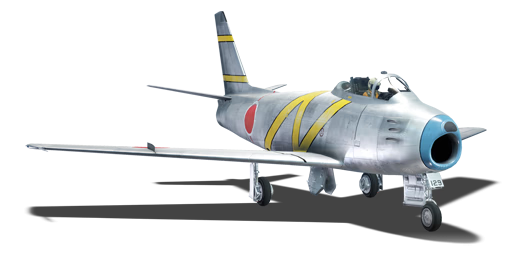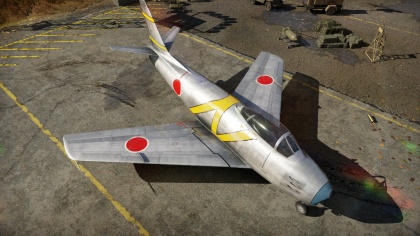F-86F-30 (Japan)
Contents
| This page is about the Japanese jet fighter F-86F-30 (Japan). For other versions, see F-86 (Family). |
Description
The F-86F-30 Sabre ▅ is a rank V Japanese jet fighter
with a battle rating of 8.0 (AB), 8.3 (RB), and 8.7 (SB). It was introduced in Update 1.39.
General info
Flight performance
| Characteristics | Max Speed (km/h at 0 m - sea level) |
Max altitude (metres) |
Turn time (seconds) |
Rate of climb (metres/second) |
Take-off run (metres) | |||
|---|---|---|---|---|---|---|---|---|
| AB | RB | AB | RB | AB | RB | |||
| Stock | 1,095 | 1,089 | 14700 | 24.7 | 25.9 | 38.8 | 35.9 | 750 |
| Upgraded | 1,115 | 1,106 | 23.6 | 24.0 | 56.5 | 46.7 | ||
Details
| Features | |||||
|---|---|---|---|---|---|
| Combat flaps | Take-off flaps | Landing flaps | Air brakes | Arrestor gear | Drogue chute |
| ✓ | ✓ | ✓ | ✓ | X | X |
| Limits | ||||||
|---|---|---|---|---|---|---|
| Wings (km/h) | Gear (km/h) | Flaps (km/h) | Max Static G | |||
| Combat | Take-off | Landing | + | - | ||
| 0 | 350 | 620 | 620 | 350 | ~12 | ~7 |
| Optimal velocities (km/h) | |||
|---|---|---|---|
| Ailerons | Rudder | Elevators | Radiator |
| < 850 | < 600 | < 650 | N/A |
Engine performance
| Engine | Aircraft mass | |||||
|---|---|---|---|---|---|---|
| Engine name | Number | Empty mass | Wing loading (full fuel) | |||
| General Electric J47-GE-27 | 1 | 5,430 kg | 239 kg/m2 | |||
| Engine characteristics | Mass with fuel (no weapons load) | Max Takeoff Weight | ||||
| Weight (each) | Type | 7m fuel | 20m fuel | 26m fuel | ||
| 1,150 kg | Axial-flow turbojet | 5,787 kg | 6,429 kg | 6,726 kg | 9,530 kg | |
| Maximum engine thrust @ 0 m (RB / SB) | Thrust to weight ratio @ 0 m (100%) | |||||
| Condition | 100% | WEP | 7m fuel | 20m fuel | 26m fuel | MTOW |
| Stationary | 2,626 kgf | N/A | 0.45 | 0.41 | 0.39 | 0.28 |
| Optimal | 2,626 kgf (0 km/h) |
N/A | 0.45 | 0.41 | 0.39 | 0.28 |
Survivability and armour
- 6.35 mm steel - in front of cockpit
- 12.7 mm steel - behind pilot
- 38 mm steel - armoured windscreen
- 20 mm steel pilot's headrest
Modifications and economy
Armaments
Offensive armament
The F-86F-30 (Japan) is armed with:
- 6 x 12.7 mm M3 Browning machine guns, nose-mounted (300 rpg = 1,800 total)
Suspended armament
The F-86F-30 (Japan) can be outfitted with the following ordnance:
- Without load
- 16 x HVAR rockets
- 2 x 1,000 lb AN-M65A1 Fin M129 bombs (2,000 lb total)
Usage in battles
Describe the tactics of playing in the aircraft, the features of using aircraft in a team and advice on tactics. Refrain from creating a "guide" - do not impose a single point of view, but instead, give the reader food for thought. Examine the most dangerous enemies and give recommendations on fighting them. If necessary, note the specifics of the game in different modes (AB, RB, SB).
Modules
| Tier | Flight performance | Survivability | Weaponry | ||
|---|---|---|---|---|---|
| I | Fuselage repair | Compressor | Offensive 12 mm | ||
| II | New boosters | Airframe | FRC mk.2 | ||
| III | Wings repair | Engine | New 12 mm MGs | ||
| IV | G-suit | Cover | FLBC mk.1 | ||
Pros and cons
Pros:
- Clear cockpit view for simulator battle
- Decent turn time for jet
- Good acceleration
- Decent armament 12.7mm M3 with a high rate of fire
- Can carry bombs or rockets
- Decent radar
Cons:
- Easy to rip off the wings with high-speed manoeuvres (realistic and simulator battles)
- This plane against jet with afterburner and missile
- Low ammo count equates to only 15-second burst
History
Following the Japanese defeat and the end of the Second World War, Japan was prohibited from maintaining armed forces of its own. Following the disbanding of the Imperial Japanese Army and Navy in 1945, this decision was written into law in the 1947 Constitution. While the original article declared that Japan would never resort to war as an instrument to settle disputes and would never maintain land, sea or air forces or other instruments of war, later on the exact meaning of this article was questioned by successive governments as it meant Japan was fully dependent on the occupying Allied forces to come to its defence in case of an armed conflict. The outbreak of the Korean War in 1950 only furthered this concern, and a new interpretation of the constitutional article came into being: while Japan was prohibited from maintaining an offensive force, the article did not state that they were also prohibited from maintaining a purely defensive force.
The formal establishment of a mutual defence clause in the 1951 US-Japan Peace treaty led to the founding of the Japanese Self-Defense Forces in 1954, with the Japanese Air Self-Defense Force being its air component. As a result of negotiations concerning the founding of the JASDF, it was eventually decided that the new armed force would use the North American F-86F as its standard day-fighter, with license production being undertaken by Mitsubishi in the form of assembly of knock-down kits produced by the North American factory in California. However, as it would take time for production to start, the decision was taken to hand over USAF aircraft to the nascent JASDF pending the arrival of the first domestically-produced F-86Fs. This first delivery included 30 North American F-86F Sabres and 55 Lockheed T-33A Shooting Star jet-trainers.
The official handover of the first seven F-86Fs for the JASDF took place at Kisarazu Base on December 1st 1955; the last of the 30 aircraft was handed over four months later in April of 1956. This first tranche of 30 aircraft, consisting of 10 F-86F-25-NHs and 20 F-86F-30-NAs, was originally used as a stop-gap pending the delivery of the F-86F-40 variant intended for the JASDF. These aircraft served to equip the 1st Air Wing, which was officially declared operational on October 1st 1956. In the four years they served as daylight fighters, 2 aircraft were written off in accidents. As soon as sufficient North American and Mitsubishi-produced Block-40 aircraft became available, the 28 surviving F-86F-25s and -30s were put into storage.
This was not the end of their story, as 18 aircraft were converted to RF-86F reconnaissance aircraft in 1961. These aircraft were used to equip the 501st Squadron where they would have a surprisingly long career: the last of these RF-86Fs were only withdrawn from service in 1979.
The following F-86Fs were transferred from the USAF to the JASDF:
- F-86F-25-NH: 51-13361; 51-13368; 51-13369; 61-13376; 51-13385; 51-13390; 51-13414; 51-13474; 52-5327; 52-5439
- F-86F-30-NA: 52-4542; 52-4618; 52-4679; 52-4684; 52-4693; 52-4699; 52-4705; 52-4708; 52-4745; 52-4758; 52-4836; 52-4844; 52-4845; 52-4905; 52-4909; 52-4913; 52-4914; 52-4916; 52-4923; 52-4939
These aircraft were (randomly) renumbered in JASDF service as 52-7401/7409 and 62-7410/7430. Aircraft later converted to RF-86F standard were renumbered from the x2-74xx to x2-64xx.
Media
Excellent additions to the article would be video guides, screenshots from the game, and photos.
See also
- Related development
- Canadair Sabre (those Sabres manufactured with the designator "CL")
- North American F-86D Sabre
- North American F-100 Super Sabre
- North American FJ-4 Fury
- Aircraft of comparable role, configuration and era
- Dassault Super Mystère
- Grumman F-9 Cougar
- Hawker Hunter
- Lavochkin La-15
- Mikoyan-Gurevich MiG-15
- Mikoyan-Gurevich MiG-17
- Saab J29 Tunnan
External links
- http://dansa.minim.ne.jp/His-Mil-F86F-002-Photo1-1.htm
- http://www.joebaugher.com/usaf_fighters/p86_12.html
| North American Aviation | |
|---|---|
| Fighters | |
| P-51A | P-51 · P-51A |
| P-51C | P-51C-10 |
| P-51D | P-51D-5 · P-51D-10 · P-51D-20-NA · P-51D-30 |
| P-51H | P-51H-5-NA |
| Twin-engine fighters | F-82E |
| Jet fighters | F-86A-5 · F-86F-2 · F-86F-25 · F-86F-35 · F-100D |
| Strike aircraft | A-36 · PBJ-1H · PBJ-1J |
| FJ-4B · FJ-4B VMF-232 | |
| Bombers | B-25J-1 · B-25J-20 |
| Export/Licence | ▂B-25J-30 · ␗B-25J-30 |
| ▄Mustang Mk IA · F-6C-10-NA · ␗P-51C-11-NT · ␗P-51D-20 · J26 David · J26 · P-51D-20-NA · ␗P-51K | |
| F-86F-30 ▅ · ␗F-86F-30 · F-86F-40 ▅ · F-86F-40 JASDF▅ · ␗F-86F-40 | |
| ◄F-86K · ▄F-86K (Italy) · ▄F-86K (France) | |
| ␗F-100A · ▄F-100D · ␗F-100F | |
| Captured | ▅P-51C-11-NT |
| Canadair Limited license-built the F-86 as the CL-13 for use in Canada and export to Europe. | |
| Fiat license-built the F-86K for the Italian Air Force though another 120 NAA built F-86Ks were also sold to the Italians. | |
| See Also | Mitsubishi Heavy Industries · Canadair Limited · Fiat Aviation |
| Japan jet aircraft | |
|---|---|
| IJNAS | |
| Experimental | Kikka |
| Reconnaissance | R2Y2 Kai V1 · R2Y2 Kai V2 · R2Y2 Kai V3 |
| IJAAS | |
| Fighters | Ki-200 |
| JASDF | |
| Fighters | F-86F-30 ▅ · F-86F-40 ▅ · F-86F-40 JASDF▅ |
| F-104J | |
| F-4EJ Phantom II · F-4EJ ADTW · F-4EJ Kai Phantom II | |
| F-15J · F-15J(M) | |
| F-16AJ | |
| F-1 | |
| Trainers | T-2 Early · T-2 |
| Foreign | |
| Thailand | ▄AV-8S · ▄F-5E FCU |





